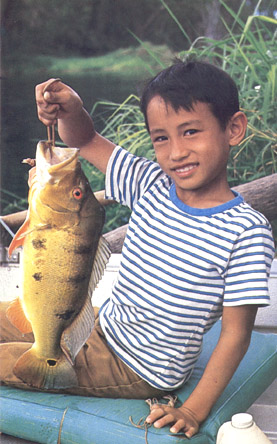
Introduced into the State from British Guiana in1957, the tucunare has rapidly become the most popular game fish in the areas where it has been stocked.
Also known as peacock bass, due to its similiarity in shape and habits to the largemouth bass, the tucunare is in fact not related to any common North American species. Its powerful, laterally compressed body and aggressive temperament makes it pound-for-pound one of the hardest fish to handle on light tackle. In South America sportsmen go to fantastic lengths to fish for the tucunare.
The tucunare is more than just a fighter. It is not only beautifully colored but very tasty as well.
Tucunare (Cichla ocellaris)
Other Common Names: Peacock bass; pavon; lukanani; tuc.
Description: The tucunare is a basic yellow with a green back and a white abdomen. During the spawning season the yellow coloration along the sides of the fish intensifies, and the male develops a large, fatty hump above the head. A black spot , or ocellus, on the tail fin characterises the species. Average size ranges from two to three pounds.
Distribution: Ranging throughout South America, the tucunare is most abundant in the warm still waters of the Amazon Basin region. Tucunare and related species have recently been introduced to Florida and the southeastern United States. In Hawaii large population are found in the Wahiawa Public Fishing Area on Oahu and private resevoirs on Kauai. Tucunare have also been stocked on Maui and Hawaii..
Food: The diet is restricted almost exclusively to small fish, principally threadfin shad, tilapia, bluegill and mosquito fish.
Life History: Spawning in Hawaii occurs from April to September when water temperature reach 80 degrees F or higher. The eggs are laid on a rock or other hard substance in shallow water and are guarded by one or both parents. Hatching takes place within four days, and the parents guard the young. An average of 5,000 eggs is placed on each nest, but less than 1% of these survive to adulthood. Tucunare matures at 12 to 13 inches, and may retain this size within a year. Since the presence of at least one parent is mandatory throughout the incubation period for egg survival, sportsmen are urge not to disturb actively spawning fish which are often visible near shore.
Habitat: The tucunare is found in the larger, warm water resevoirs in the State. The fish becomes inactive below 70 degrees F, and total motality of the young occurs at 60 degrees F.
Fishing Methods: Light spinning or bait casting outfits are recommended. Mosquito fish or other small fish make excellent bait. Light spinning lures that resemble threadfin shad are also highly effective.
Local Record: 7 pounds 13 ounces (1980) Kauai. (Last known state record 8 pounds 13 ounces)
Kindly made available by Mr.
Howard Takata of Hilo
![]() Go
Back
Go
Back